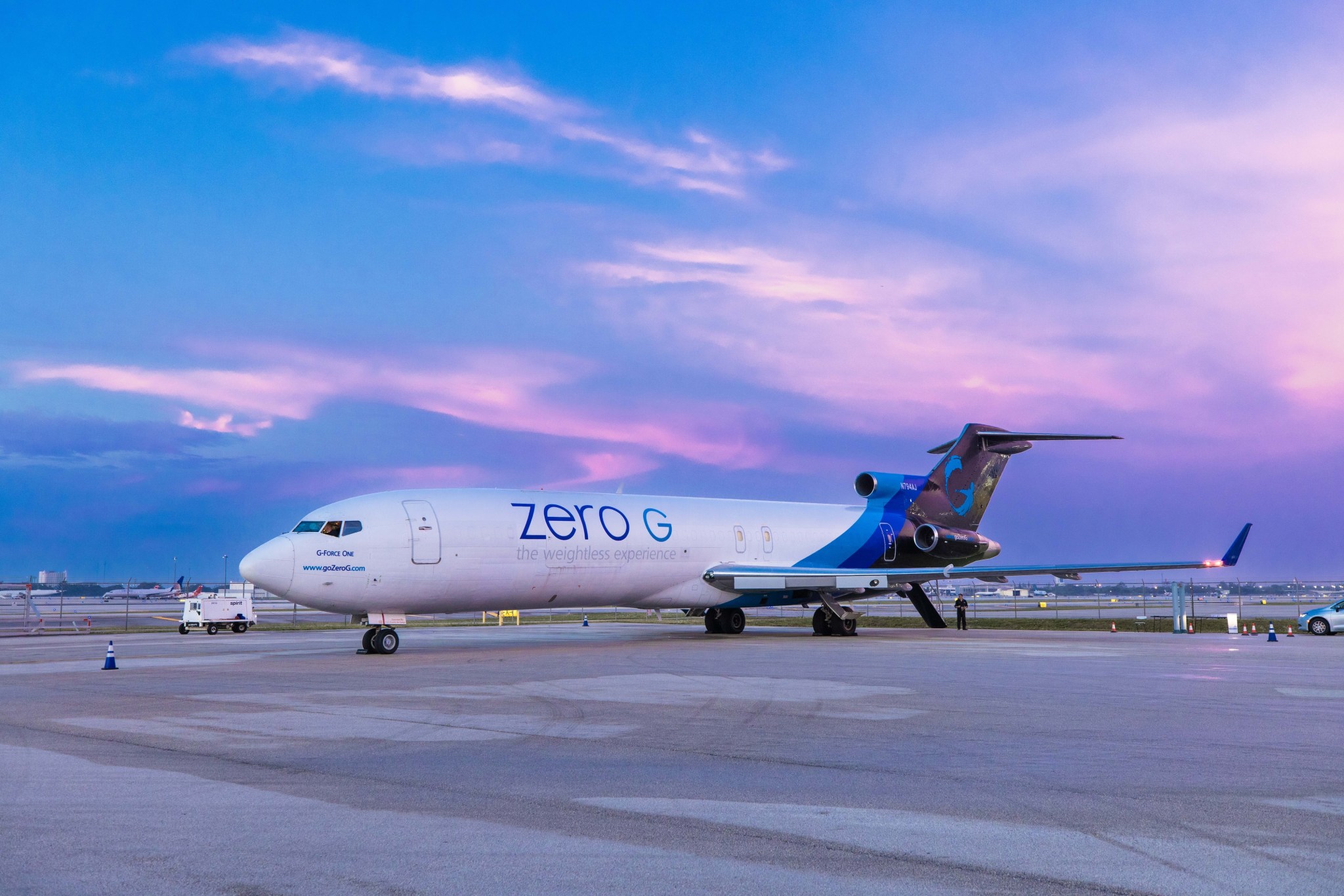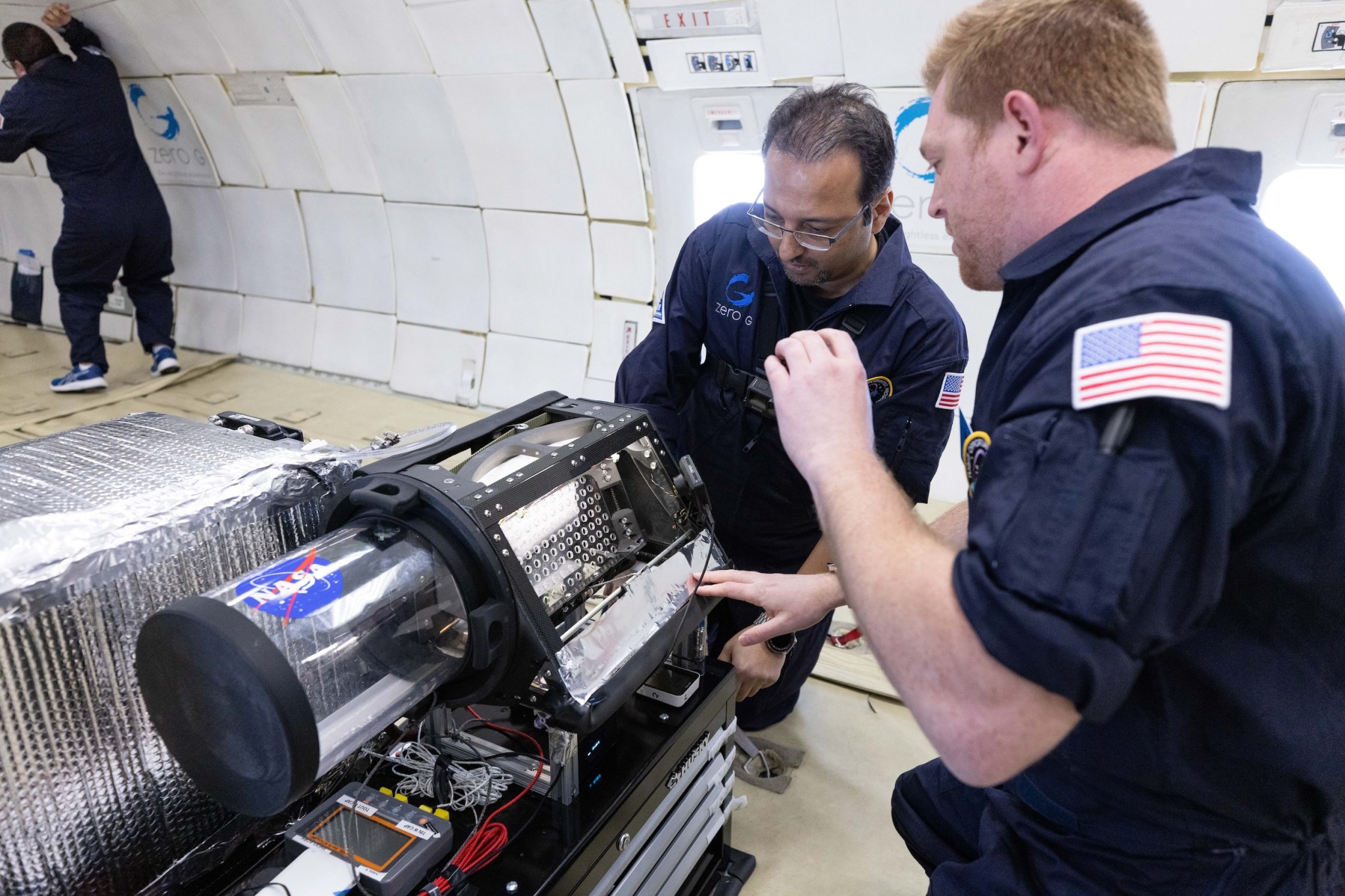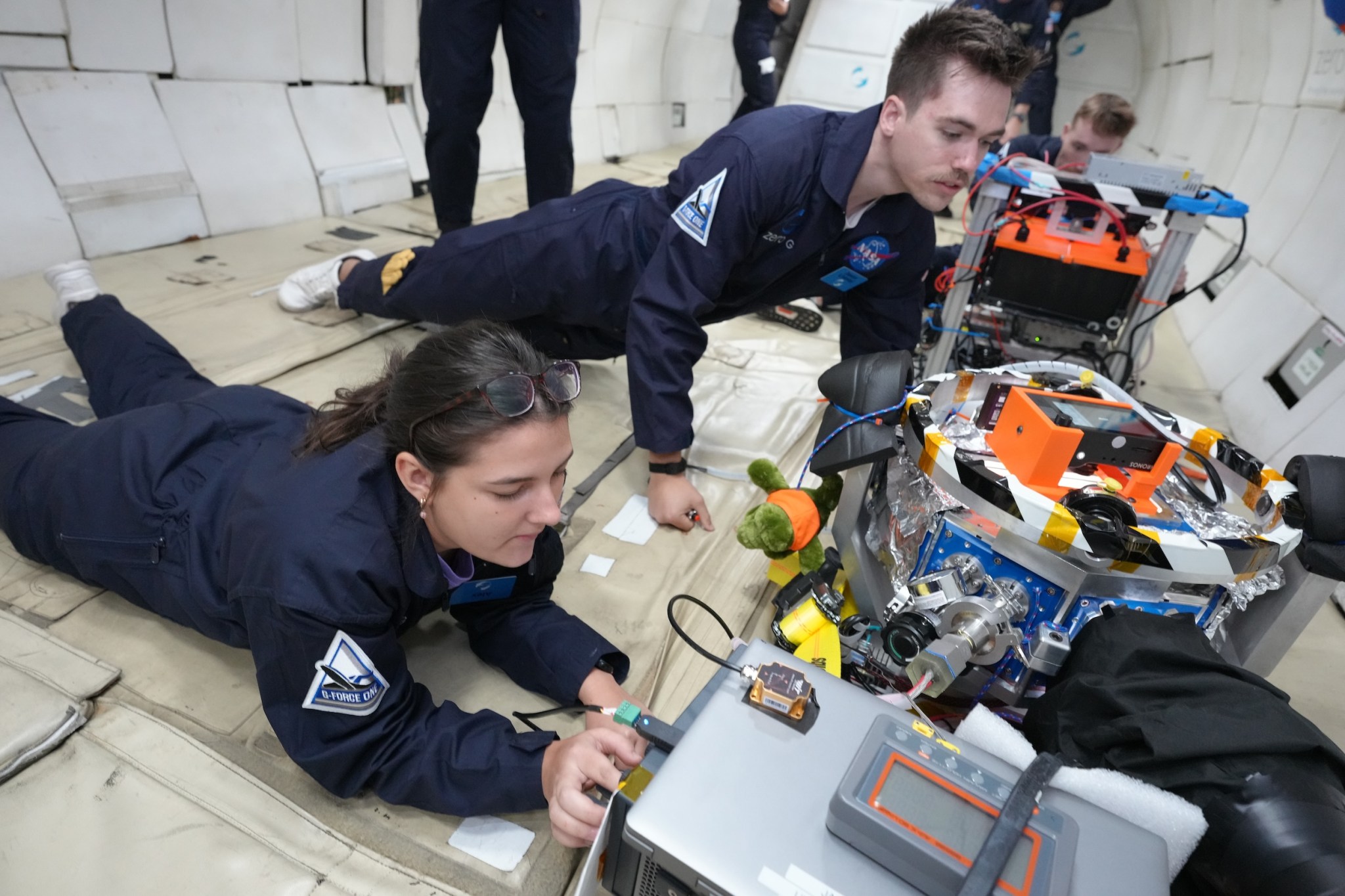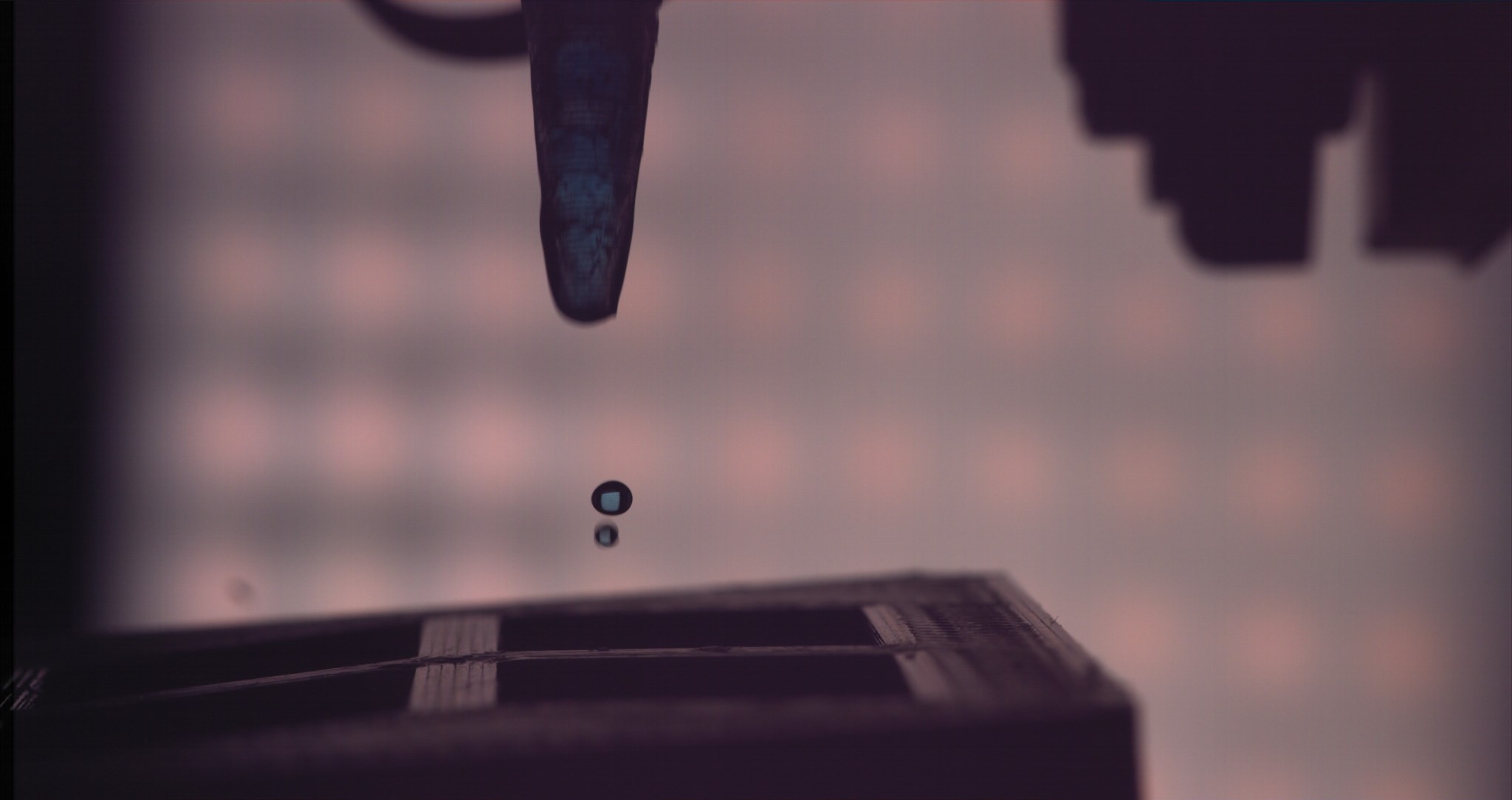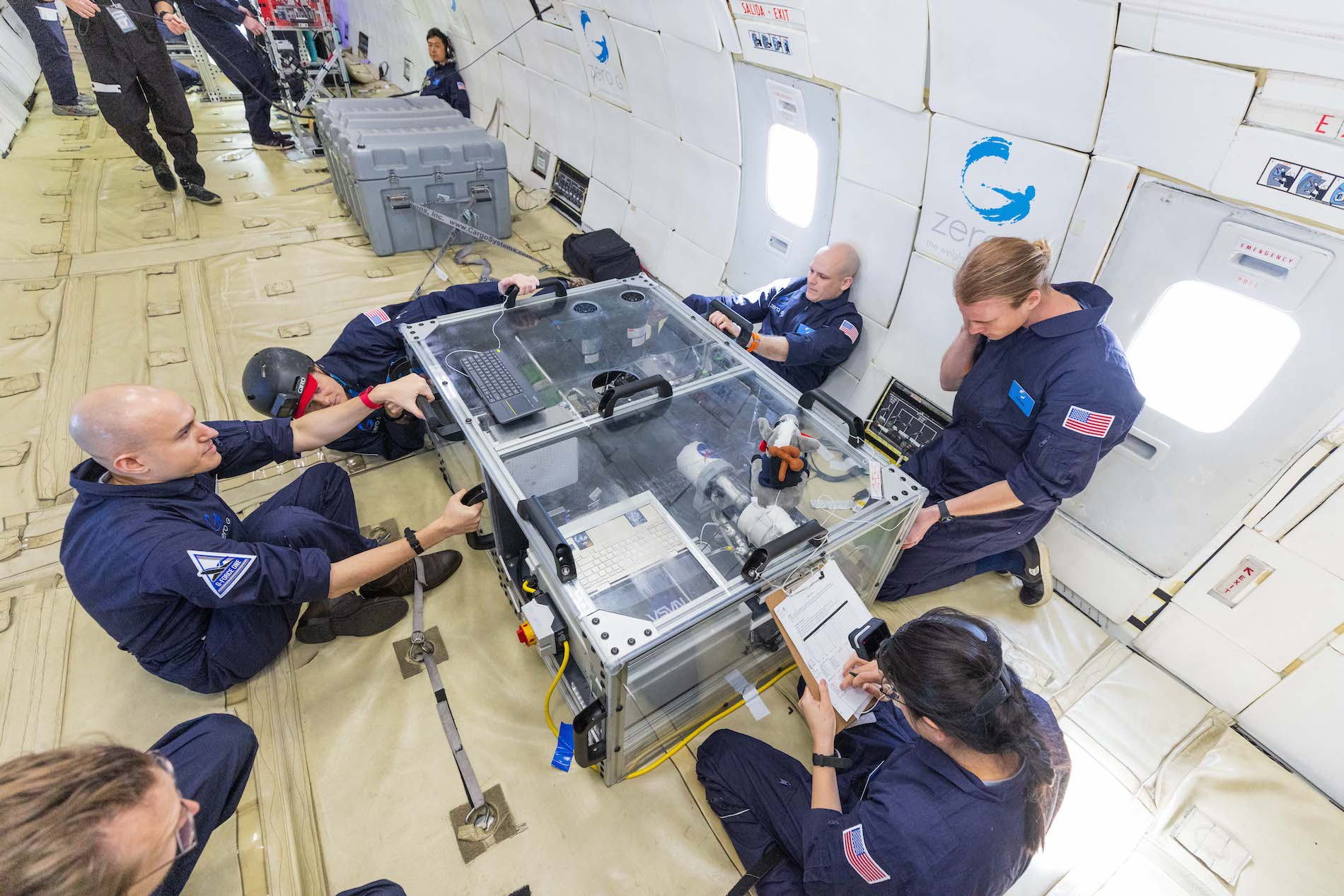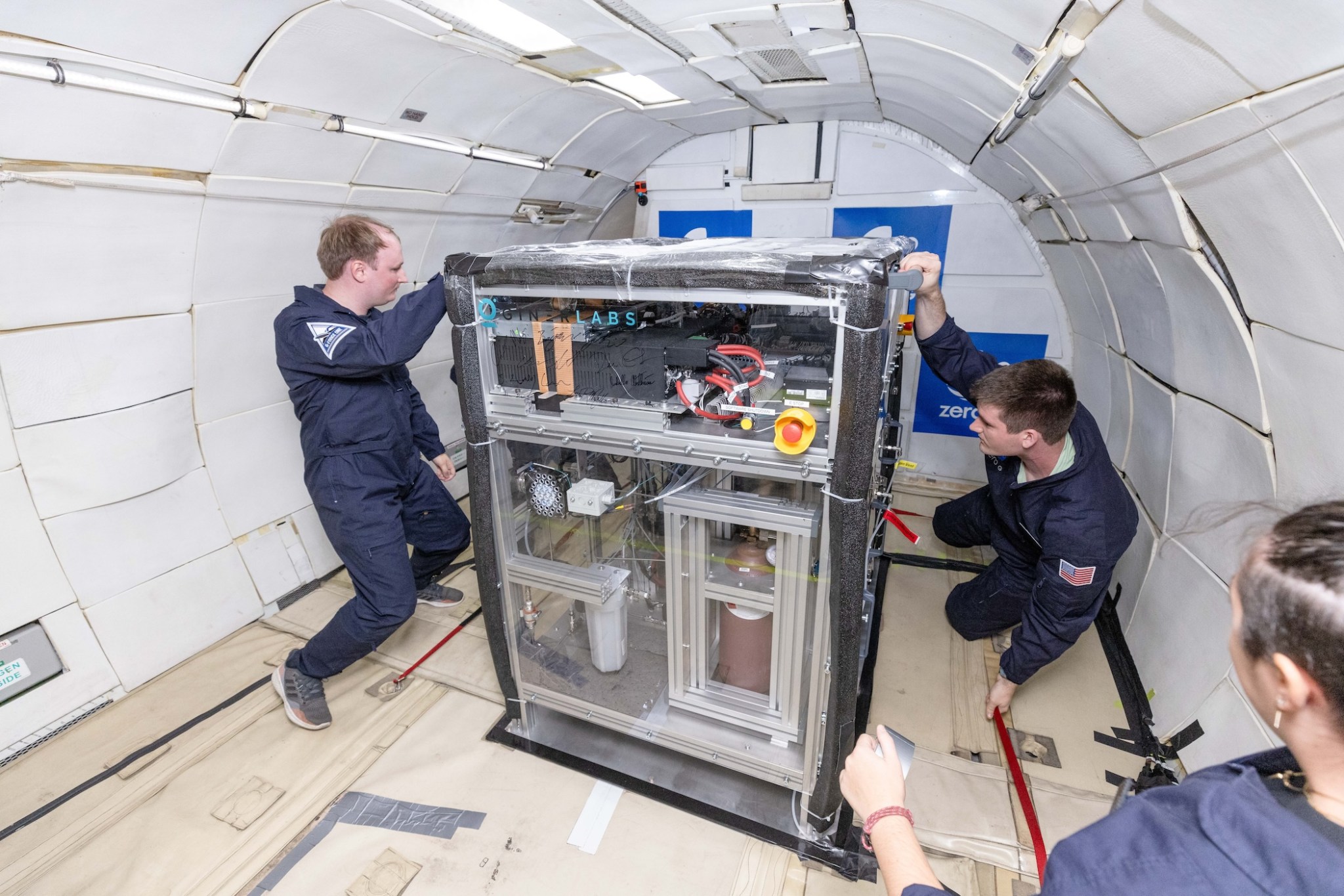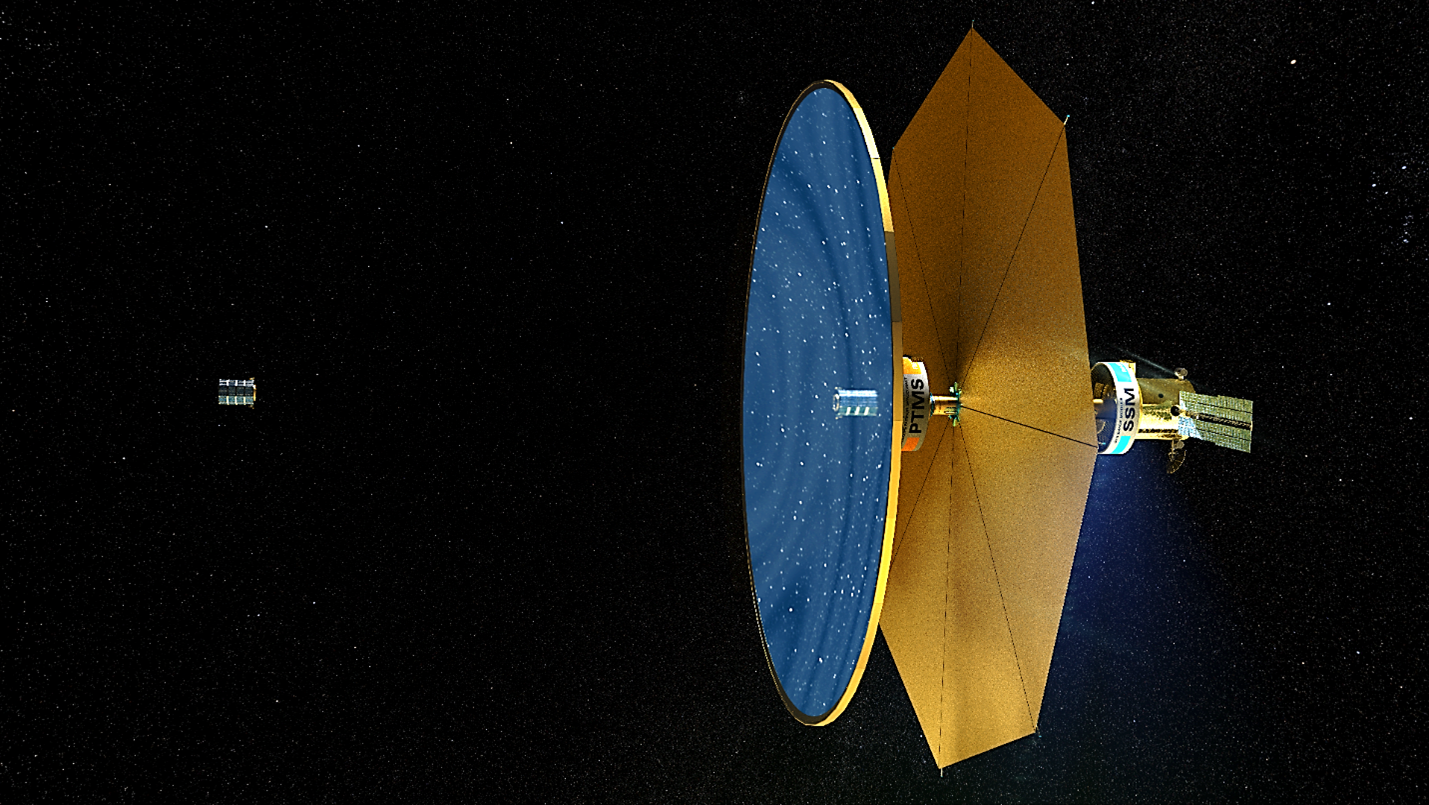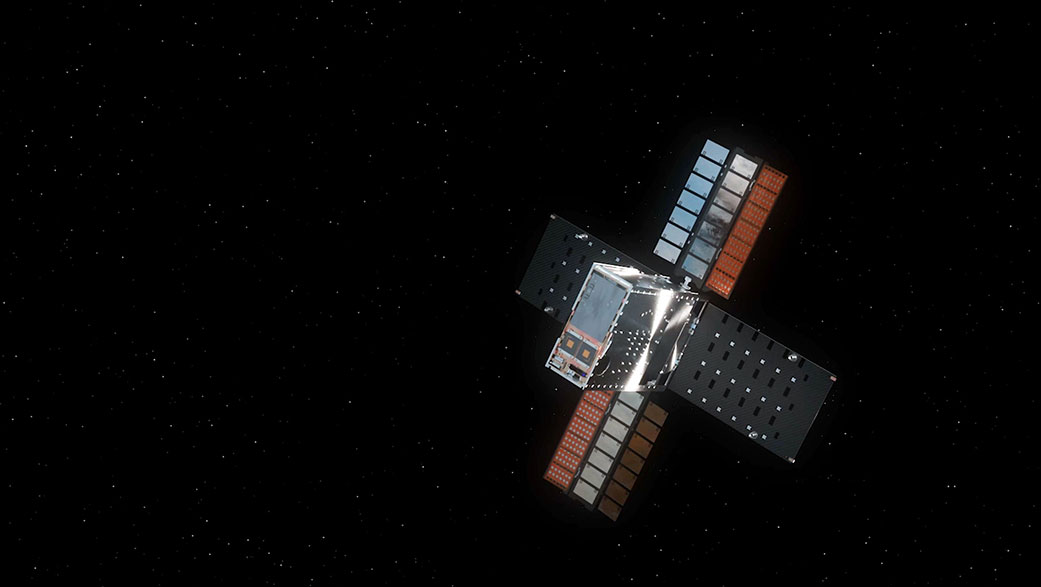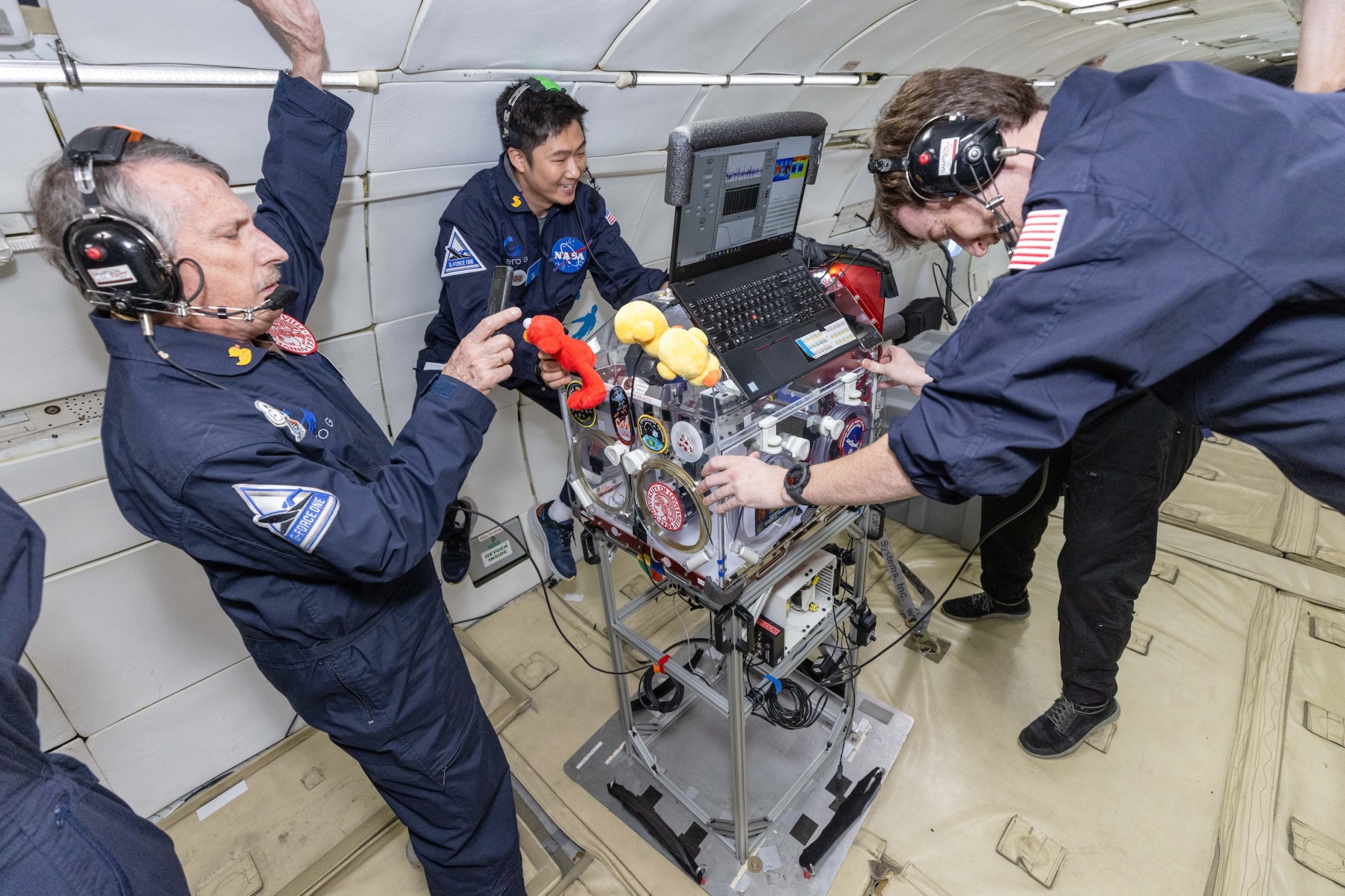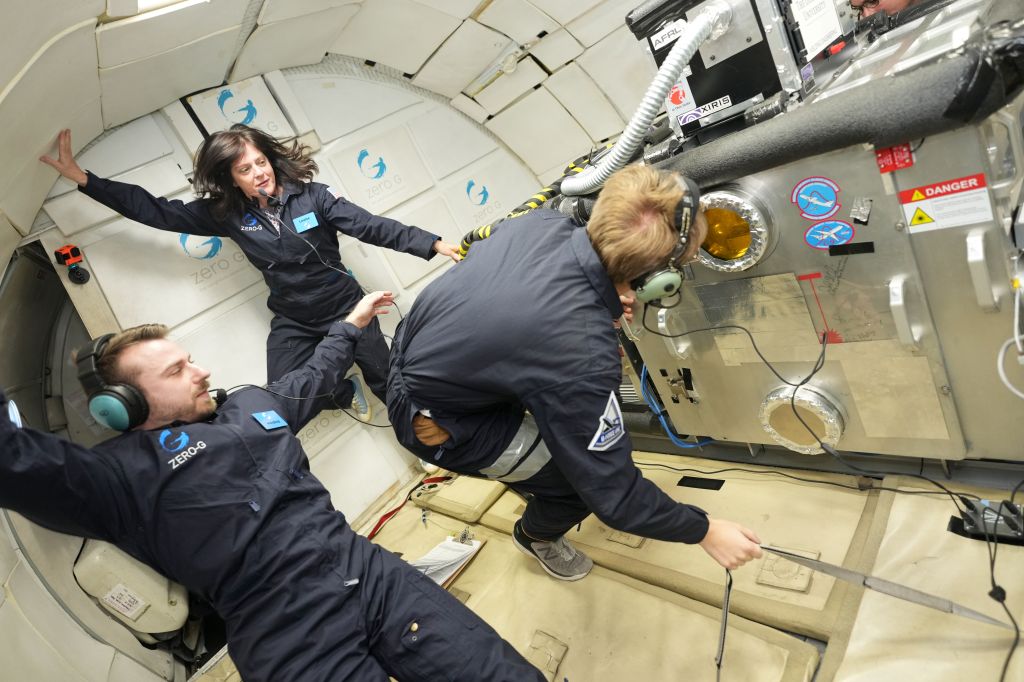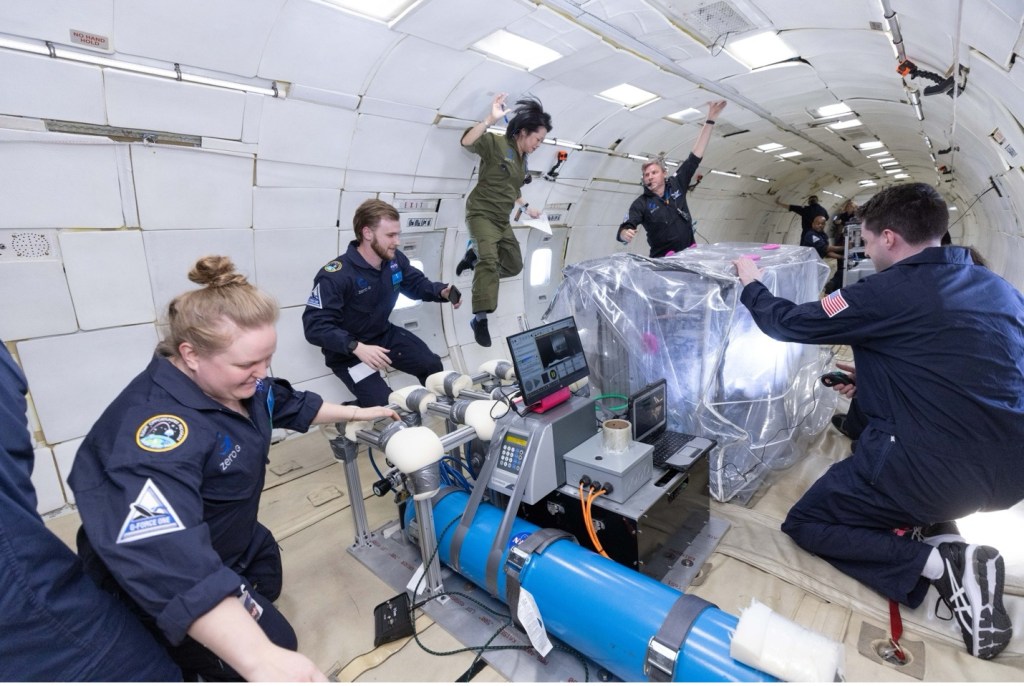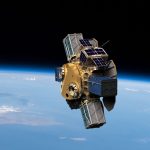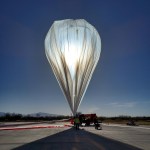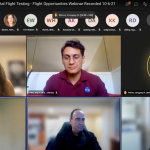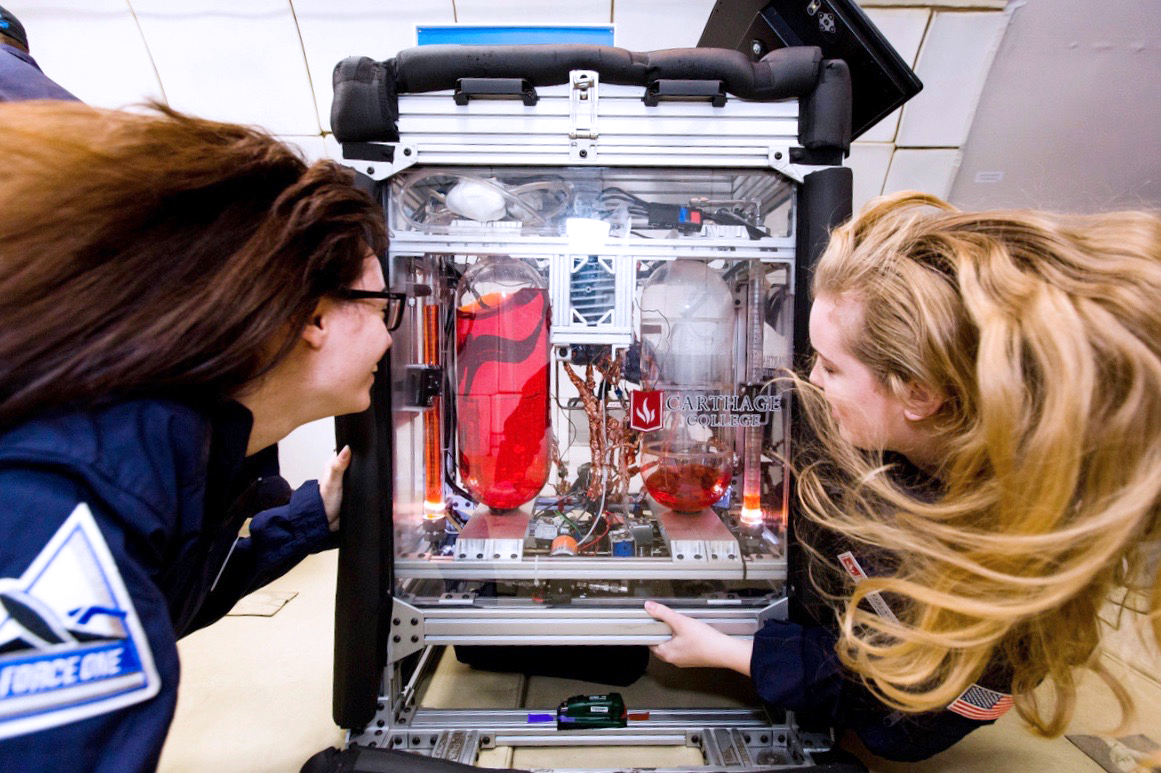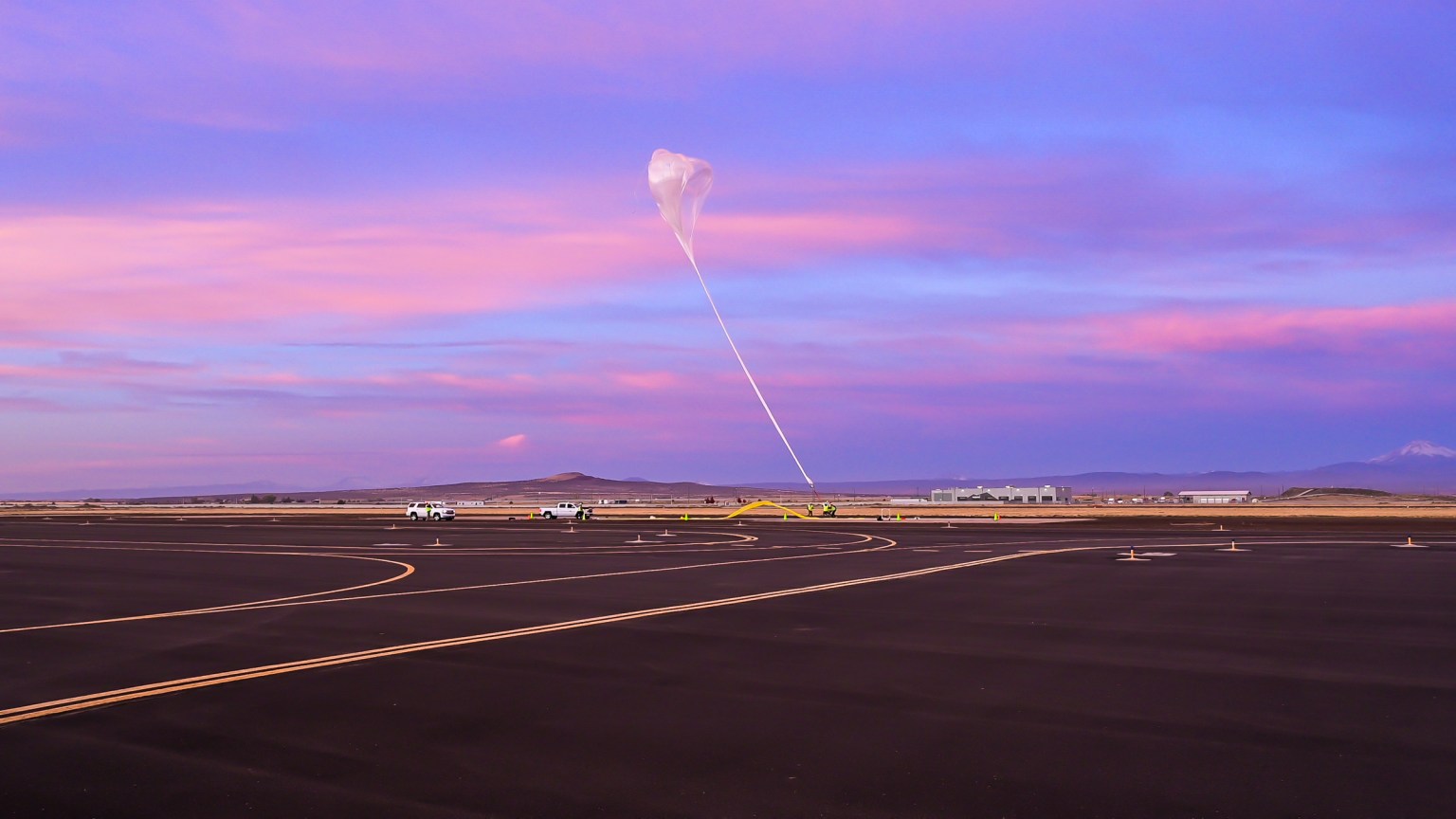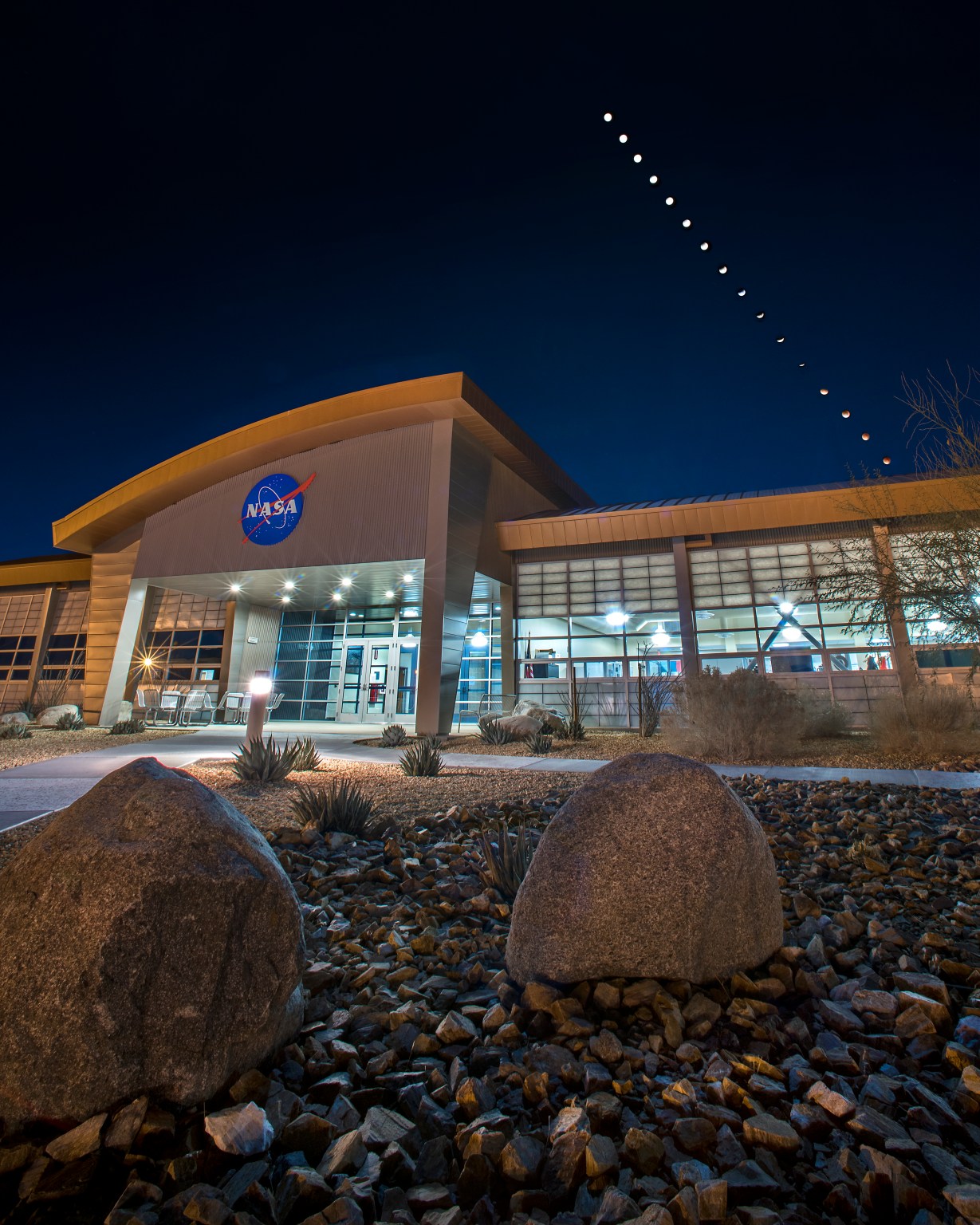NASA’s Flight Opportunities program supported the testing of more than 30 technologies on parabolic flights in 2024. During brief periods of microgravity as well as lunar gravity, researchers collected data for projects that address several technology shortfalls across the civil space ecosystem. With this data, researchers will prepare for orbital demonstrations aboard the International Space Station, enhance their technologies for further suborbital testing, and share their findings with the scientific and technology community. (Credits: Zero Gravity Corporation unless otherwise noted.)
Flight Provider
Zero Gravity Corporation
Flight Test Platform
Aircraft flying parabolic profiles
Flight DateS
February – November 2024
Locations
Fort Lauderdale, FL;
Santa Maria, CA; and
Jacksonville, FL
Advanced Habitation Systems | Advanced Manufacturing | Advanced Materials and Structures | Autonomous Systems and Robotics | Cryogenic Fluid Management | Entry, Descent, and Landing |
In-Situ Resource Utilization (ISRU) | Power | Sensors and Instruments | Small Spacecraft |
Thermal Management Systems

Characterizing Production and Stability of Nanobubbles in Variable Gravity
Arizona State University researchers successfully demonstrated during the parabolic flight in November that nanobubbles generated on Earth maintain stability even under extreme gravity changes, including zero gravity. Their experiments further revealed that nanobubbles can be generated in zero gravity conditions, enabling highly efficient gas-liquid contact processes. This capability could significantly enhance the performance of systems that depend on gas exchange, reducing both the operational footprint and resource requirements for implementation in space-based applications. These findings open new possibilities for optimizing life-support and fuel systems in space environments.

Human Waste Ultrasonic Dryer
Ultrasonic Technology Solutions tested a prototype of an ultrasonic drying device for human solid waste in reduced gravity during the April flight. Water recovery and solid waste stabilization are critical for astronaut health on long-duration space missions. The device had its origins in the Department of Energy’s Oak Ridge National Laboratory. The technology development is supported by the agency’s SBIR program and the Logistics Reduction program under Space Operations Mission Directorate’s (SOMD).

Capturing Human Adaptations in Novel Gravitational Environments in Space (CHANGES)
During the October flight, researchers at the University of California, Davis tested a wearable, non-pharmaceutical countermeasure to motion sickness induced by head motion. In spaceflight, symptoms of motion sickness can undermine astronaut performance and pose a threat to mission safety and efficiency. By inducing head movement in the weightless period of a parabolic, flight the team verified that their device alerted the user to motions that would increase their risk of feeling sick, but that it needs modifications to perform reliably in hypergravity.

Large-Scope Bioprinting in Microgravity
During the February flight, researchers from the Center for Applied Space Technology tested a bioprinter prototype as proof-of-concept for a full-scale, commercial bioprinting facility in low Earth orbit. Bioprinting in microgravity could allow for the large-scale production of cells and tissues more efficiently than on Earth.

Acoustofluidics-Based Multifunctional Manipulation of Micro- and Nanoparticles
Researchers from Mississippi State University examined the acoustic effects on micro- and nanoparticles (or colloids) suspended in liquids under reduced gravity during the April flight. Colloids have shown potential for additive manufacturing, drug delivery, and more. Researchers aim to develop a novel 3D printing platform that can actively manipulate colloids in reduced gravity, arranging them in resins and fabricating polymer composites containing patterned or aligned particles. This work is supported by NASA’s Established Program to Stimulate Competitive Research (EPScoR).

On-Demand Manufacturing of Electronics (ODME) Advanced Toolplate
During the August flight, researchers from NASA’s Marshall Space Flight Center in collaboration with Sciperio and Redwire Space tested a newly developed advanced toolplate with eight miniaturized swappable toolheads for infusion into a low-gravity, on-demand manufacturing system for flexible, hybrid electronic devices currently under development. The technology is supported by the Space Mission Technology Directorate’s (STMD) Game Changing Development program under its ODME project.

Electrohydrodynamic (EHD) Ink Jet Printer Advanced Toolplate Integration
Researchers from NASA's Marshall Space Flight Center and Iowa State University successfully printed several silver lines during the zero gravity 30-second period during the August flight, concluding that the Sciperio EHD printer performs well under a zero-gravity environment. The printer also showed capability of printing with zinc-oxide ink. This technology is supported by the STMD Game Changing Development program under its ODME project.

Space Enabled Advanced Devices and Semiconductors (SEADS)
During two flights in March, researchers from NASA, industry, and academia took the first step in studying the use of a novel 3D printing technique that leverages electrohydrodynamic inkjet printing (EHD) to manufacture advanced memory devices in microgravity. This work is a continuation of prior parabolic flight tests in 2021 and 2022 to mature the technology. Collaborators included Intel, University of Wisconsin-Madison, Arizona State University, and Iowa State University. This technology is supported by the STMD Game Changing Development program under its ODME project, in conjunction with the Space Operations Mission Directorate’s (SOMD) In Space Productions Applications (InSPA).

Manufacturing of Semiconductors and Thin-Film Integrated Coatings (MSTIC)
A research team from Redwire Space collected microgravity data of the facility known as MSTIC during the February flight. This autonomous semiconductor manufacturing platform is a collaborative effort with the International Space Station National Laboratory and NASA and is supported by SOMD’s InSPA.

Fluids at Altitude Mixing Experiment (FAME)
During the March flight, Redwire Space also tested a variety of liquid-handling processes associated with hardware designed to test multiple crystallization conditions in microgravity and provide samples back to Earth for analysis. The goal of this hardware is to provide services to pharmaceutical and institutional researchers seeking to use target molecules in their crystalline state to reformulate existing products and/or develop formulations for new products. The development of this hardware is supported by SOMD’s InSPA.

Activation of Self-Folding Origami in Microgravity Environment (AoSOME)
During the October flight, researchers from Auburn University observed and captured the first samples of shape memory polymers self-folding in microgravity under infrared (IR) light. The computer system responded accurately to inputs, which confirmed that the control system could turn the sample carousels, initiate the experiment with IR light, and digitally record the experiment. As a result of the flight test, the team will make modifications and revisions to their experimental apparatus for operating in microgravity.

Space Metal Processing System
In November on their second parabolic flight, researchers from CisLunar Industries successfully cast their first full aluminum billet under microgravity conditions. They also tested an upgraded version of Steer, their contactless 3D molten metal manipulation system, for the first time in microgravity. These tests pave the way for an upcoming mission to the International Space Station, which will operate key components of a space foundry system designed to enable large-scale fabrication.

Laser Welding Experiment to Enable Maturation of Computational Models and Process
Researchers from NASA's Marshall Space Flight Center and The Ohio State University performed the first ever demonstration of high-power fiber laser beam welding under high-vacuum and micro- and lunar-gravity conditions during parabolic flight in August. This validation dataset has the potential to anchor computational models that will enable one-shot laser beam welds in space and on the Lunar surface and may be crucial to manufacturing, assembly, and repair that could ensure long-term sustainability between the Earth, Moon, and Mars.

Novel Technology for Key Material Property Measurement
During flights in August and October, researchers from the University of Florida assessed a method for manufacturing metals and alloys in microgravity. The technology will be used to determine a key thermophysical property needed for efficient advanced manufacturing in space. Successful operation of the technology was proven in microgravity, and testing also showed an enhancement of heat transfer.

Understanding Wheel-Regolith Interaction for Mobility Under Lunar Gravity
During the October flight, ProtoInnovations researchers flew the first variable-slope single wheel testbed on a lunar gravity flight. Data collected from this experiment should improve the characterization of the locomotion and mobility performance of robotic rovers, autonomous controls, and novel electromechanisms and tools of relevance to lunar missions involving scientific investigations with environmental manipulations.

Microgravity Lab Assistant: A Compact Robot for Sample Preparation on Space Station
During a flight in November, Sierra Lobo researchers demonstrated that the Microgravity Lab Assistant, a compact robot with basic manipulation and machine vision capabilities, can accurately perform fluid transfer in zero-gravity environment using its robot arm and specialized end effector. The zero-g experiments identified the conditions that eliminate stray droplet production during fluid transfer.

Strata-2P: Characterizing Sensor-Regolith Interactions
During the April flight, University of Central Florida tested technologies for investigating the formation and interaction of small particles and layered structures in low-gravity environments to inform robotic and in-situ exploration. Specifically, researchers aim to provide a more detailed understanding of the behavior of dust and regolith on the surfaces of planetary bodies, including how those surfaces respond to disturbances and the subsequent effect on reduced-gravity operations.

Noninvasive Detection of Liquid Propellant Location
During the March flight, researchers from Carthage College tested their noninvasive propellant gauging technology designed to facilitate the transfer and storage of cryogenic propellants in microgravity — a key need for refueling of the power and propulsion element for future Gateway lunar station-keeping.

Lightweight, Reliable Cryogenic Screen Channel Acquisition Devices
During the April flight, Creare tested a liquid acquisition device designed to advance cryogenic fluid management in orbit and on the lunar surface. The device optimizes the position of residual liquid in a fuel tank to improve expulsion efficiency and could address the need for vapor-free propellant on long-duration missions. This technology has been developed through NASA’s Small Business Innovation Research/Small Business Technology Transfer (SBIR/STTR) program.

Computational Fluid Dynamics Boiling Models
Massachusetts Institute of Technology (MIT) researchers collected data during the March flight to optimize models for cryogenic fluid management through predictive simulations of boiling heat transfer. Accurate modeling of phase change in cryogenic propellants is critical for long-duration crewed missions.

Impact of Surface Properties on Cryogenic Boiling and Quenching
Researchers from MIT also conducted experiments during the November flight to study cryogenic fluid quenching on different surfaces using specialized diagnostics that enable imaging the boiling process at the microscale in both time and space. The results of these experiments, which are important for understanding the behavior of cryogenic fuels in microgravity conditions, will support the design and development of future in-space cryogenic storage and transfer systems.

Stability of In-Space Cryogenic Systems
New Jersey Institute of Technology researchers gathered data during the February flight to understand propellant stability during activities such as refueling, specifically as it relates to temperature and mechanical disturbances. The storage and transfer of cryogenic propellants in microgravity is important for lunar and deep space exploration. Results from the flight test could lead to a strategy to enhance safety and prevent hydraulic shocks.

Measuring Cryogenic Two-Phase Heat Transfer Coefficients for In-Space Transfer Systems
During the March flight, Purdue University researchers performed reduced-gravity experiments to gather heat flux data as part of an ongoing effort to develop more precise computational models. These models support the prediction of flow boiling to improve the design of in-space cryogenic fluid management systems and cryogenic propellant transfer systems.

Nucleation of Cryogenic Bubbles in Spacecraft Liquid Acquisition Devices
Another payload from Purdue University sought to understand questions raised during a precursor NASA project on the International Space Station, where vapor bubbles formed during a reduction in test tank pressure. On April parabolic flights, researchers tested a liquid-vapor nitrogen system to explore thermodynamic states and relevant changes, with the goal of helping to advance long-term cryogenic propellant storage in the weightlessness of space.

Measurement of Spray Heat Transfer During Cryogen Chilldown of Receiver Tank
Researchers from Purdue University and NASA’s Glenn Research Center studied the two-phase physics observed during steady-state testing of cryogenic sprays during the November flight. This study is expected to directly impact the design and modeling of LEO tank-to-tank propellant transfer and has revealed new insights into the interactions between atomized droplets and heated surfaces while negating gravity’s influence. Results will be used to inform the efficient design of cryogenic tank chilldown operations to optimize propellant consumption and enable missions with larger payloads traveling further into our solar system.

Development of Cryogenic Propellant Storage Tank Inner Surface Coating
During the April flight, University of Florida researchers tested the effectiveness of several coating candidates to minimize or eliminate propellant boiloff, which can occur on a storage tank’s internal surface from external heat leakage and hotspots. The vapor generation due to boiloff can result in pressure buildup requiring the venting of propellant. Exploring and developing capabilities of the various coating materials and surface finish combinations could lead to substantial propellant savings.
Credits: Auburn University

3D Plume-Surface Interaction and Crater Formation Dynamic Measurements
During lunar landings the rocket plume disturbs regolith, which can result in cratering, severe lunar dust blowing, and particle ejecting. During flights in March and April, Auburn University researchers gathered data on plume-surface interaction in reduced and lunar gravity conditions to better understand the underlying physics and enable safe landings.

Comminution of Regolith Using Milling for Beneficiation of Lunar Extract (CRUMBLE)
Interlune researchers measured the performance of a milling system for crushing/processing raw lunar regolith simulant into feedstock for ISRU during the October flight. The testing included multiple chambers with lunar regolith simulant under vacuum, tested in a lunar gravity environment to assess trade-offs in size, weight, and power required for different performance levels. This is a first of a kind experiment, the results of which can be used for many types of ISRU as well as extraction of helium-3 from lunar regolith.

In-Situ Resource Utilization Through Gas Fermentation
Mango Materials, Inc. evaluated a membrane-based bioreactor designed to convert methane into a biopolymer during the March flight. The technology could enable sustainable additive manufacturing using resources available on the Moon, on the station, or in space.

Effects of Extraterrestrial Gravity on Soil Fluidization Imposed by an Ultrasonic Probe
During the April flight, NASA’s Glenn Research Center tested a lunar excavation tool that leverages the use of forced, resonant vibration to fluidize soil around the leading edge of a probe or shovel, requiring less force for the tool to move through the soil. Reduction of excavation forces for a given tool can enable vehicle mass reduction and thereby reduce launch costs. Also supported by STMD’s Game Changing Development program, this technology for extraterrestrial mining or prospecting machinery could enable commodity production on the lunar surface.

Non-Flow-Through Fuel Cell System for High-Density Energy Storage
During the October flight, researchers from Giner Labs demonstrated their system, which uses an integrated gas-liquid separation membrane to passively remove water without excess flow of reactants to improve fuel utilization and simplify plant balance. This testing helps advance the technology readiness level (TRL), enabling this technology to potentially be used to create high-density, long-duration energy storage for a variety of missions.
Credits: Above graphic by Edward Balaban.

Fluidic Telescope Experiment (FLUTE)
Researchers from NASA's Ames Research Center tested the Fluidic Telescope Experiment (FLUTE) during the August flight to validate the method for developing fluidic optical components in microgravity conditions for use in space telescopes and optical components. The approach leverages the natural surface tension of liquids to achieve nanometer smooth optical surfaces. Parabolic flight testing permitted researchers to test different liquids, geometries, and deployment mechanisms and to optimize conditions for future development of the method.
Credits: NASA/JPL-Caltech

Thermomagnetic SmallSat Propellant Positioning
During the October flight, Georgia Institute of Technology researchers demonstrated thermomagnetic SmallSat propellant positioning, which explores repositioning saturated two-phase propellants for accurate impulse delivery in cold-gas SmallSat architectures. This first parabolic flight demonstrated that a concentrated heat source within a two-phase CubeSat propellant tank can effectively and efficiently reposition the ullage gas bubble within the container, enabling a new propellant management architecture with 30% total impulse increases with respect to the state of the art. The design will be refined for testing on a flight in 2025.

Thermal Transport Characterization of Phase Change Material (PCM)
During the March flight, Mississippi State University tested a novel PCM design solution that combines the high heat absorption of PCMs with the high thermal conductivity of additively manufactured octet-shaped metal foam meshes. The objective is to enhance the understanding of the phase-change process under microgravity conditions and to address the PCM incorporation challenges. This work is also supported by NASA’s Established Program to Stimulate Competitive Research (EPScoR).




























